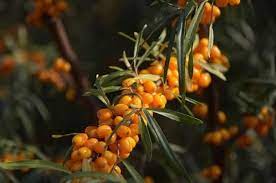Sea buckthorn : Awarded GI Tag

Sea buckthorn fruit from Ladakh has been recently awarded a GI tag.
- Sea buckthorn (Hippophae rhamnoides) is a plant found throughout Europe and Asia.
- In India, it is found above the tree line in the Himalayan region, generally in dry areas such as the cold deserts of Ladakh and Spiti.
- It is naturally distributed over 11,500 hectares in the Ladakh region.
- It produces small orange or yellow-coloured berries that are sour in taste but rich in vitamins, especially vitamin C.
- The shrub can withstand extreme temperatures ranging from minus 43 degrees Celsius to 40 degrees Celsius and is considered drought-resistant.
- These two characteristics make the shrub an ideal plant species to establish in cold deserts.
- Sea Buckthorn berries have the unique characteristic of remaining intact on the shrub throughout the winter months despite the subzero temperature.
- It has been used traditionally for a variety of purposes.
- Every part of the plant—fruit, leaf, twig, root, and thorns—has been traditionally used as medicine, nutritional supplement, fuel, and fence.
- Many bird species feed on the berries when other sources of food are limited in the region.
- The leaves serve as protein-rich fodder for cold desert animals like sheep, goats, donkeys, cattle, and double-humped camels.
- Therefore, it is popularly known as the ‘Wonder Plant’, ‘Ladakh Gold’, ‘Golden Bush’, or ‘Gold Mine’ of cold deserts.




